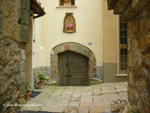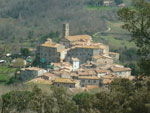Lovely La Leccia
in Maremma Pisana territory
La Leccia: nothing to do, nothing to see (or so I thought), but a lovely place to simply be... This tiny hamlet which once had its own castled church can be found in Maremma Pisana territory, between the bigger castled towns of hot rock Sasso Pisano and Serrazzano. But only if you catch the single track entrance in time along the road's twisty route from the Valle del Diavolo - the valley of the devil.
Those were the words I wrote in my notebook before I left La Leccia. But when I got home and started the research for this page, WOW, I was knocked-off my feet with its massive amount of history, its legend and not to mention a miracle or two!

Why does Maremma always do that to me? :) I come home after a day out exploring and decide to write what I think will be a simple page about one of the smaller places I have visited only to be hit full in the face with the enormity of one "borgo's" past! I love Maremma :) Always full of surprises.
Situated on the top of a less prominent foothill it is hidden away from sight from the twisty road that passes below it and is dominated by the way above sea level hill top towns of Sasso Pisano on one side and and Serrazzano on the other. La Leccia takes its name from the oak woodland that surrounds it: "leccio", in Italian means holm-oak or ilex.
Take a walk from the village and and you will find wild orchids in the meadows and glades nearby.

Sadly, there is no longer a school or bar open here: the former's garden is now overgrown and the building decaying. But, nevertheless, the hamlet has a well looked after feel about it: a lot of the buildings have been restored using traditional stone and, as is usual in every village in Maremma, a few have scaffolding attached to them in a way that is impossible to tell whether it is in preparation for a forthcoming restoration project or to keep the building up!
The tiny village gardens are full of vegetables flowers and olive trees... And there is land with olive trees for sale here and a house if you are interested in making your home overlooking this stunning geothermic Tuscan landscape.
 The village "piazza" has its own central well
The village "piazza" has its own central well It will be a quiet life if you do: for there is nothing more to do than sit on the wall or take in the view from the square and watch the traffic finding its way along the bends in the road below... that is if there was much traffic to watch. The busiest time when I was there was when a German cycling tour group passed by!
A little bit of history, a legend and a miraculous event
For a tiny sleepy place (only fifty people are formally recorded as living there), La Leccia has a lot of history and a legend all of its own.
 The ruin remains of Leccia castle
The ruin remains of Leccia castle The very first recordings of this medieval "borgo" date to 1028, when its fortified castle was the subject of a transaction of lands and property between members of the feudal and noble Cadolingi family, which participated actively in the religious struggles in Tuscany at the time.
At the beginning of the twelfth century part of the castle was donated by some of the Counts Aldobrandeschi to the Benedictine monastery of San Piero di Monteverdi, to whom in 1176 Pope Alexander III confirmed that they held a sixth of the title to the castle.
That same Pope also confirmed ownership rights over La Leccia to the bishops of Volterra.
Maremma is full of similar stories of parts of its fortresses and castles belonging to different groups of people, all of which have one thing in common: some of the castle was donated at some time to the church in payment for debt, support, a bishops title etc.
And throughout that century a perpetual fight ensued for dominating control of La Leccia between the Bishops of Volterra and the City of Volterra. Despite repeated by the Bishops contestations to the Pope and even the Holy Roman Emperor to confirm their sovereignty -
- by Pope Urban III in 1186
- and that same year, the holy Roman Emperor, Henry VI, confirmed ownership of the castle to Volterra Bishop Ildebrando Pannocchieschi,
which, perhaps unsurprisingly was granted every time - the City of Volterra continued to win its long-term aim of gaining control over the castle, its lands and men and the majority of the territory. In 1204 the men of the castle of Leccia conceded their allegiance to the City. But the Bishops still didn't give up, and in 1259 Bishop Ranieri demanded the payment of taxes by the City until, in the end an agreement was reached.
That ownership of this tiny place was so important had nothing to do with its modern day tranquility or beauty, but all to do with ownership and control of the rich alum mines in the lands that formed part of the territory of Sasso Pisano.
The village has suffered from landslides and collapses in the sixteenth, eighteenth and nineteenth centuries as well as the plague. Two of the churches four bells were donated by survivors of the plague.
The La Madonna del Libro -
The Madonna of the Book painting
I didn't know it when I visited La Leccia but the village church - "la chiesa di San Bartolomeo Apostolo" (the church of Saint Bartholomew the Apostle) is home to a painting called "La Madonna del Libro" - the Madonna of the Book - dated 1599. Originally destined for the Chiesa della Madonna del Libro, it was painted by the Leccia born artist Matteo Gondi (also known as Matteo da Leccia and Perez) (1540 - 1632).

When I visited in April the church was well and truly locked-up, so if you want to see the painting I suggest that you ask one of the locals if they have a key. Best to "catch" one when you see them, as the two retired gentlemen that I met tending their gardens etc had "disappeared" into their allotments when I had wanted to ask another question.
Santuario della Madonna del Libro -
the Sanctuary of the Madonna of the Book

The painting was originally displayed in what from the village looks like a newly-built villa across the other side of the main road, with a typical Tuscan cypress tree lined route of a drive. But which is in fact the restored Santuario della Madonna del Libro - the Sanctuary of the Madonna of the Book.
The sanctuary was built in memory of a miraculous event that is recorded as having taken place in 1472 during a war between Lorenzo de'Medici and the City of Volterra for ownership of the alum mines of Sasso Pisano.
The local population prayed to the Virgin Mary for divine help in saving them from the horrendous bloody attacks of the Medici Florentine military and one day a local woman "appeared" promising peace and that they would be dealt with kindly. What occurred thereafter is unclear from the legend that has been passed down from generation to generation, but one has to assume it was a positive outcome.
The sanctuary has was built to a T-shape with a large arched covered arcade on three of its sides. This porched arcade transforms the original "T" into a triangle and makes it a unique design of its age not only in Tuscany, but the whole of Italy. It is of Andean origin and is believed to have been brought back by the artist Leccia's artists, Matteo Gondi, on his return from his stay in Lima, Peru during the seventeenth century.
La Fonte del Latte - the Fountain of Milk
Close to the sanctuary - but now in private land - can be found a natural spring of warm water which legend has it - and so effective was it that it was backed by medic approval in the sixteenth century (Andrea Bacci, doctor to Pope Sixtus V) - can return milk to new mother's who have stopped lactating.
 View of the Sanctuary of the Madonna with the Book in the immediate background and of the castled Tuscan hill town of Serrazzano in the far distance.
View of the Sanctuary of the Madonna with the Book in the immediate background and of the castled Tuscan hill town of Serrazzano in the far distance. Legend has it that a woman visited the spring and made three pledges, drank three or four gulps of the water and recited a prayer. On her route home her breasts filled with milk. Women who followed in her footsteps were required to commit to one of the pledges, similarly drink the water and make a prayer to the Virgin Mary.
A chapel was built at the source of the spring in the fourteenth century, but today nothing remains as a great flood of the river Cornia demolished it.
The video
Access and parking
You probably won't believe that the sign is in the right place and that the main "into town" access road is the sharp angled single-track road when you see it. But it is.
Parking: well, it seems silly even putting up the heading! As you enter the hamlet - it is a dead end - you'll find parking on stilts on your right opposite the closed school. Or, you can park alongside the old castle wall. It won't be busy!
Village Festival
The annual village festival takes place on the 1 May of each year.
More places to explore nearby
 Valley of the devil!
Valley of the devil!  Serrazzano
Serrazzano
Explore some more...

















